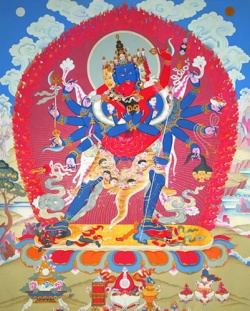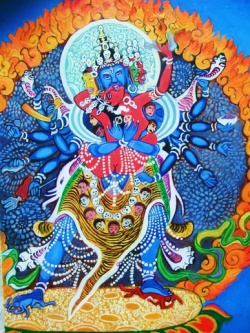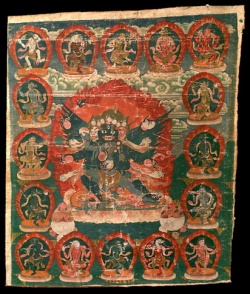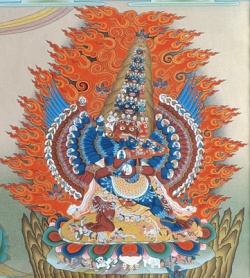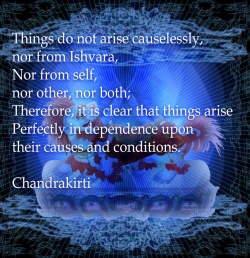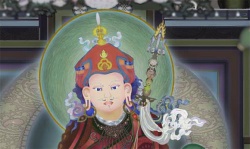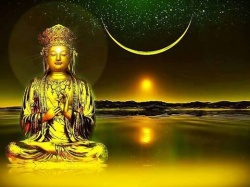Heruka
Heruka (Sanskrit; Tib.khrag 'thung), is the name of a category of wrathful deities, enlightened beings in Vajrayana Buddhism that adopt a fierce countenance to benefit sentient beings.
In China and Japan, it was named as Wisdom King. Herukas represent the embodiment of indivisible bliss and emptiness.
They appear as yidam or meditational deities in tantric sadhana, usually placed in a mandala and often accompanied by a yab-yum consort.
Heruka is a Sanskrit word that has a number of different meanings depending on the tantra in which it is defined. In the Tibetan language the word heruka is translated as drag tung which means blood drinker. When the term heruka is used in art and iconography it generally has three different meanings as found below.
In the Nyingma (Old) Tradition Heruka generally refers to any male-meditational deity, wrathful in appearance, typically with three faces, six arms, four legs, wings and a consort. There are eight famous Nyingma Heruka deities. Some deities with a semi-peaceful - semi-wrathful appearance, arising from specific Revealed Treasure Traditions, may also be referred to as Heruka.
In the Sarma (New) Traditions of Sakya, Kagyu, Jonang and others, the term Heruka typically refers to any complex Anuttarayoga male-meditational deity, peaceful or wrathful, that appears in a simplified form with one face, two arms and a consort.
In the Gelug Tradition (also belonging to the Sarma) the term Heruka almost exclusively refers to the complex meditational deity Chakrasamvara in all aspects.
Jeff Wat 1-2010
Derivation and meaning of the term
The name "Heruka" is made up of the prefix "he-" meaning "hey!" and "ruka", a rich term implying many levels of subtle meaning - richness, royalty, etc.
It is linked to the Sanskrit word "Rc" which is where the name "Rgveda" comes from.
The name of Ruchiraketu, the famous bodhisattva from the Mahayana sutra The Sovereign King of Sutras, the Sublime Golden Light(suvarnabhasottamendraraja) means "He Who Fly's the Banner of Riches (ruchira)". He is considered by some to be an emanation of a Heruka.
The Sanskrit term Heruka was translated into both Chinese and Tibetan as "blood drinker," which scholar Ronald Davidson calls "curious," speculating that the nonliteral translation derived from an association the term has with cremation grounds and 'charnel grounds' (Sanskrit: śmāśāna) (which absorb the blood of the dead).
Sanskrit terms for blood drinker include asrikpa, reflecting a Sanskrit word for blood (asrik), and raktapa, raktapayin, or rakshasa, derived from an alternate root term for blood (rakta).
Unlike the Chinese and Tibetan (Tratung, wylie: khrag 'thung) terms used to translate it, the Sanskrit term heruka does not literally mean blood drinker, although the fact that it was rendered as such into two other languages strongly suggests an according Indian interpretive etymology.
Eight Herukas of the Nyingma Mahayoga
The eight Herukas (Wylie: sgrub pa bka’ brgyad) of the Nyingma mahayoga tradition (and their corresponding sadhanas) are said to have been received by Padmakara from the Eight Vidyadharas (Tib. Rigdzin), or Eight Great Acharyas:
Manjushrimitra,
Nagarjuna,
Vajrahumkara,
Vimalamitra,
Prabhahasti,
Dhanasamskrita,
Shintamgarbha and
Guhyachandra.
They were proficient in the practices of, respectively,
- 1) Yamantaka (Tib. Jampal Shinje, ’jam dpal sku) the wrathful Manjushri, the deity of body
- 2) Hayagriva (Tib. Pema Sung, padma gsung) the wrathful Amitabha, the deity of speech
- 3) Vishuddha/Sri Samyak (Tib. Yangdak Thuk, Wylie: yang dag thugs) the wrathful Vajrapani deity of mind
- 4) Vajramrita (Tib. Dudtsi Yonten, bdud rtsi yon tan) the wrathful Samantabhadra, the deity of enlightened qualities
- 5) Vajrakilaya/Vajrakumara (Tib. Dorje Phurba, phur ba ‘phrin las), the wrathful Vajrasattva, the deity of purification
- 6) Matarah (Tib. Mamo Botong, ma mo rbod gtong) the wrathful Akasagarbha, the deity of calling and dispatching
- 7) Lokastotrapuja-natha (Tib. Jigten Chotod, ’jig rten mchod bstod) the wrathful Ksitigarbha, the deity of worldly offering and praise
- 8) Vajramantrabhiru (Tib. Mopa Dragnak, mod pa drag sngags) the wrathful Maitreya, the deity of wrathful mantras
Padmasambhava is quoted in the Bardo Thodol (Antarabhavatantra - "Tibetan Book of the Dead"):
"The crucial point is indeed that those who have meditated on the formal description of these Herukakaya ('bodies of Heruka'), and also made offerings and praise to them, or, at the very least, have simply seen their painted and sculpted images, may recognise the forms that arise here and attain moksha (liberation)."
Source
The heruka (Tib. ཧེ་རུ་ཀ་, Wyl. he ru ka) is another name for wrathful deity. In the Nyingma tradition the term is often used to refer specifically to Chemchok Heruka or Yangdak.
Definition
According to a tantra:
- He stands for great compassion.
- Ru means the absence of gathering.
- Ka means not abiding in anything whatsoever.[1]
In the Zindri, Khenpo Ngakchung says that, according to Patrul Rinpoche, heruka means "one in whom absolute space (he) and primordial wisdom (ka) are united (ru)."[2]
In the Nyingma tradition, it is used as a general name for (male) wrathful deities.
In the sarma schools of Tibetan Buddhism, Kagyü, Sakya and Geluk, heruka generally refers to Chakrasamvara and other chief deities of the mandalas of the Mother Tantras.
The term Heruka can also be used to denote a realized tantric practicioner. [3]
Footnotes
- ↑ Quoted in Jamyang Khyentse Chökyi Lodrö, Yeshe Saldrön.
- ↑ Khenpo Ngawang Pelzang, A Guide to the Words of My Perfect Teacher (Boston: Shambhala, 2004), p. 275.
- ↑ Katok Situ Chökyi Gyatso, Togden Shakya Shri, The Life and Liberation of a Tibetan Yogi', Shang Shung Publications, 2009, page 243.
Further Reading
- Padmasambhava & Jamgön Kongtrul, Light of Wisdom, Vol. 1 (Hong Kong: Rangjung Yeshe, 1999), p.64-65 & 170.
External Links
Source
Heruka. (T. Khrag ’thung; C. Xilujia; J. Kiruoka; K. Hŭiroga 嚕迦). Sanskrit proper name of a spirit that perhaps originally was associated with cremation grounds (Śmaśāna) and was a form of Śiva (Maheśvara).
The name appears commonly in tantric Buddhism as a generic name for a buddha appearing in a wrathful (Krodha) aspect, especially in the form of Cakrasaṃvara, and either with or without a consort.
The name is translated into Chinese and Tibetan as “blood drinker,” an interpretation not reflected in the Sanskrit. Heruka also appears in the Hevajratantra as the name of a deity who is essentially the same as Hevajra.
See also Cakrasaṃvaratantra.
Source
The Princeton Dictionary of Buddhism by Robert E. Buswell Jr. and Donald S. Lopez Jr.
Heruka; khrag ’thung (Tib). Epithet used for all wrathful deities with consort. The Tibetan term literally means ‘blood drinker,’ signifying one who has dried the blood of rebirth and death.
Source
heruka (khrag 'thung). Literally, 'blood drinker.' A wrathful deity; drinker of the blood of ego-clinging.
"HE" is the cause or ground, dharmakaya, the future, and the emancipation of non-formation. "RU" is the place, disintegration, the path and thus it is the past, the emancipation of marklessness. "KA" is the particular, the fruition and thus it is the present, nirmanakaya and the emancipation of wishlessness.
In another way, hela means "drinking" or "enjoying" (rol pa), rudhira means "blood" and kapala means "bliss sustainer" or "skull cup." Translated into Tibetan heruka means "enjoying/ drinking the blood of the skull" (thod pa'i khrag la rol pa).
That is to say, having drunken the blood of the ego-clinging and disturbing emotions in one's own stream-of-being, the heruka is drinking the the blood of the ego-clinging and disturbing emotions in stream-of-being of other disciples. In short, heruka means blood-drinker (khrag 'thung).
From Lamrim Yeshe Nyingpo.
Source
Heruka, in the Vajrayana Buddhism of Tibet and Central Asia, a fierce protective deity. He is an emanation of the buddha Aksobhya, whose figure is incorporated in his headdress.
He is depicted as blue in colour with two arms, which hold a vajra (thunderbolt) and a kapala (skull cup) full of blood. When represented in union with the female consort Vajrayogini, he is known as Hevajra, and he is widely worshipped in this form in Tibet.
Source
Heruka is a Sanskrit word that has a number of different meanings depending on the tantra in which it is defined. In the Tibetan language the word heruka is translated as drag tung which means [[bloo} drinker]].
When the term heruka is used in art and iconography it generally has three different meanings as found below.
In the Nyingma Old Tradition Heruka generally refers to any male-meditational deity, wrathful in appearance, typically with three faces, six arms, four legs, wings and a consort.
There are eight famous Nyingma Heruka deities.
Some deities with a semi-peaceful - semi-wrathful appearance, arising from specific Revealed Treasure Traditions, may also be referred to as Heruka.
In the Sarma (New Traditions of:
and others, the term Heruka typically refers to any complex Anuttarayoga male-meditational deity, peaceful or wrathful, that appears in a simplified form with one face, two arms and a consort.
In the Gelug Tradition (also belonging to the Sarma) the term Heruka almost exclusively refers to the complex meditational deity Chakrasamvara in all aspects.
Jeff Watt 1-2010
